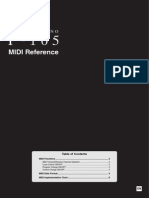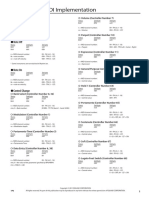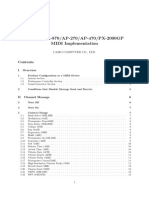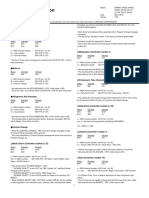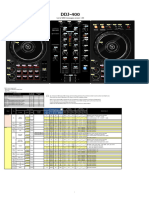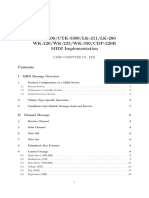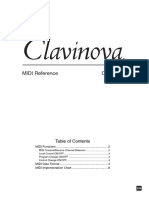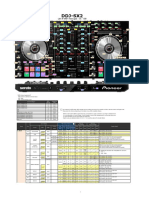0 ratings0% found this document useful (0 votes)
149 views41 pagesCasio Guidebook For Midi
Uploaded by
Marcos Alemán BayáCopyright
© © All Rights Reserved
We take content rights seriously. If you suspect this is your content, claim it here.
Available Formats
Download as PDF or read online on Scribd
0 ratings0% found this document useful (0 votes)
149 views41 pagesCasio Guidebook For Midi
Uploaded by
Marcos Alemán BayáCopyright
© © All Rights Reserved
We take content rights seriously. If you suspect this is your content, claim it here.
Available Formats
Download as PDF or read online on Scribd
You are on page 1/ 41
GUIDEBOOK
FOR
MIDI
NOV.1985
1 MIDI FORMAT
1. WHAT IS MIDI?
‘The MIDI (Musical Instrument Digital Interface) is an international standard for external control of
electronic musical instruments,
In other words, musical instruments, rhythm machines, sequencers, etc, are equipped with standard-
ized input and output terminals and the music information which the instruments send and receive
via these terminals is made compatible by a certain formating.
‘This standard enables a musical instrument to connect, synchronize, and sequence {memorize} to
other models and even to other brands.
1-1, What is MIDI Capable of Doing?
Connections can be made among keyboards, rhythm machines, sequencers, and MIDI interface
equipped computers.
[—=.
HEC) ART
TUT
NENT) ETAT In
MIDI
PARA BOX
CASIO cz
mipt
PARA OX
CASO
MIDI COMPUTER
4-2, What Data is Delivered Via MIDI?
(1) Key velocity + striking speed of keys
(2) After touch = key pressure
(3) Note data + pitch and duration
(4) Pitch bend data
(5) Program change
(6) Channel assignment : each keyboard must have a channel number that specifies which
keyboard shouid be played.
(7) Chock signal for synchronization
(8) Start/Stop signal
(9) Exclusive message : Each brands’ unique commands or data.
2, EXAMPLES OF MIDI CONNECTION
24. Remote Play
To Amplifier To Amplifior
‘Our
vAlschannel ¥ (Bhchannel 1
‘Music played on keyboard (A) is also performed on keyboard (8)
+ The same basic channel should be set on both keyboards.
2-2, Play Utilizing Digital Sequencer SZ-1.
[1) Monophonic 4-note orchestral performance.
IN Recor
To Amplitce
a 02-101 or €z1000
MONO mode
4
Together with a sequencer having minimum of four tracks such as Casio SZ-1, CZ-104 or CZ-
1000 synthesizers can play four monophonic tones simultaneausly.
* €Z-101 or CZ-1000 should be set in MONO mode, Basic channel 1, and voice channels 1
104,
Recorded muses in tracks 1 to 4 correspond to voice channels 1 to 4 of C2.101 or CZ-
1000.
{2) Polyphonic playback
our
Ww
Polyphonic Keyboard
joan
Sa) Ct
‘The keyboard plays a polyphonic music recorded in one of the sequencer tracks.
* ‘The sequencer and the keyboard should have the same channel number.
(3) Synchronous playback with a drum machine,
To Amplitier
. our our
To Amplifier
CLOCK EXT.
‘Deum Machine Set
‘This connection adds a drum machine to connection diegram (1) or (2). Drums start/stop and
tempo can be synchronized with keyboard playback.
* In this configulation, the SZ-1 is the master.
For synchronization, the clock switch of the SZ-1 must be set to INT and the drum machine
clock to EXT.
{4} Synchronized playback of a single polyphonic track and three monophonic tracks.
our
€2.101/62-1000
Polyphonic Keyboard
2s ve [Linton eae
MIDI Channel Basie Channet Basic Changi Voice Channel
Track 3°CH3
Track 4=CH4
In this configulation, polyphonic music is recorded on sequencer’s track 1. In the tracks 2 to
4, monophonic musics in different tones are recorded.
Keyboard A must be set to the POLY mode and basic channel 01.
Keyboard B should be set to the MONO mode, basic channel 02 and voice channels 02 to 04.
For playback, polyphonic musie is executed from keyboard A while three different monophonic
tones are played in keyboard 8.
{5} Synchronized playback of 4 polyphonic tracks.
‘cH=01 cH=02
mpi
PARA 80x =]
2-1 MIDI channels 1
Track 1= CHO!
Track 2» CHO
Track 3= CHO3 oHOS cE
Teack 4 = CHO
Polyphonic voices recorded in each track are played in the keyboard of corresponding channel.
2:3. Using the CZ-5000's Internal Sequencer
ae ee
Pawn 80x
cHor eno
¢z-5000
62-5000 Teacks
Track 1 = MONO
Track 2 = MONO cHos ‘CHO
Track 3 = MONO
Track 4 = MONO
Track 5 ~ MONO
Track 6 = 3.4Note POLY
cHos: cHos:
Recorded voices in tracks 1 to 6 are played in the keyboard of the basic channels 01 to 08
respectively,
Note: Only 8 voices can be recorded in CZ-5000 sequencer.
MIDI CIRCUITS
The following figure shows the MIDI connection.
Data from the transmitter’s CPU is sent to the receiver's CPU through the MIDI cable at the rate
of 31.25K baud (31,250 bits per second).
In the receiver, the photo coupler transforms the “H” or “L" level of the data into the light
energy, and then to the voltage level again to insulate against electric noises.
To
Gets
[ye OT
@ 9 pee) OS 29 counter
_—_ wen
Transmitter Maximum 15 meters Receiver
from CPU
4. MIDI FORMAT
(On data item is composed of 8 bits (1 byte) plus the start bit (always "0"
(aiways "3°" = "H1"),
"L") and the stop bit
‘Start Bit Dare Stop Bit
0 1
1n the following exptanations, the start and the stop bits are omitted.
4-1. Channel Voice Message
Channel voice messages carry data which control the voices (tones) and channel number.
(One message is composed of 2 of 3 bytes (plus two bits for the start and the stop bits in each byte).
Cian lef UCI )f PTT
The first byte is called "status byte” as it indicates what data the message carries.
The first bit of the status byte Is always 1.
The followings explain the functions of some important messages.
{1} Note ON event
First Stow) Byte | Second Byte | Third Byte
1001anan | OkkKERKK | Ovvvvewy
This message is made of three bytes and carries key number (a pitch to be sounded) and
velocity (hitting speed) information.
(EE | Se
Status byte ..... 1001nnan
‘The first four bit of the status byte 1001 indicates that a pitch should be sounded.
‘The lower half of the byte determines the channel number as shown below.
a ana | Channel No.
o000
ooo
ooo
oort
2
3
4
o100 5
o101 6
7
3
9
0
orto
2nd byte..... OkkkkkKk
‘The second byte of the Note ON event message carries a key number data.
Upon receipt of this data, corresponding key of designated channel keyboard sounds.
In order to discriminate from the status byte, the first bit of the succeeding bytes should
be 0.
The following figure indicates the relation between the key and Okkkkkkk, where the
numbers of the keys are the decimal number of Okkkkkkk.
ie, [Wem | Joa]@2 [tee [a ]2
olkle le lee lee
lle [fol lel lleloboefofed lof fol
exten one
3rd byte Ovvvvvew
The third byte of the message indicates the key velocity.
‘The following figure indicates the relation between the loudness and Ovvwvwwv.
Weakest
‘00000001
Loudest
oman
ee va 7 wh
For keyboard having no velo
feature such as CZ-101, CZ-1000 and CZ-5000, velocity
data is always transmitted and recognized as 64.
Note: 1. When two or more same messages are transmitted, the status bytes from the
second message can be omitted.
e.g, To sound C2 end E2 on channel 1
10010001 90170009 91000009 90110700 9100000
Lao 90OF COTO MrDO NCO ROL NTOP 91007009
Channel
Note ON
C2 Velocity
64
2. Velocity 0 is used as “Note Off",
(2) Control change . .
nnn
ececee
Channel eumber
+ Control number
vevuvwy: Control value
£2
1011 mann Occeecee Ovvwwwyy
Velocity
oe
‘The message conveys the information of switches and VAs of the control panel.
2nd byte
-Occcecee
cececce indicates a switch or a VR in the control panel.
ard byte
we. Ovvyyywy
vuvvvvy deseribes the status of the switch or value of the VR.
‘The following table lists the control change messages of models CZ-101/1000/5000 and
CT-6000,
€2-101/1000.
ceccece | Decimal Number Switch or VR aevuwe | Status | Transmit | Receive
ooo | OFF 2 °
‘ogoc001 1 ViBRATO ON/OFF
aitiiti | on ° °
‘0000101 5 PORTAMENTO TIME | 900000 | 00 x °
i
a1o0011 | 98
0000110, 6 MASTER TUNE so0ge00 | 9 % }
sna | 127
‘o00001 65 PORTAMENTO ‘ogo000 | OFF ° °
ON/OFF | ssiattt | on
* Transmit and Receive: © possible, x impossible
le.
CZ-101 is able to receive PORTAMENTO TIME data but cannot send it.
For sending VIBRATO ON data to channel 2, the message carries:
101} Q019 9000000) O1111114
Que a
Control Chsnne! VIBRATO ON
Change 2 switch
©z-5000
ececece | Oecimat Number | Switch or VR worn | Staws | Teonsmit | Receive
‘9000007, 1 MODULATION Wheel
2 ° °
oon010% 5 PORTAMENTO TIME | 900000 | 00 x °
2 p
nooo | 99
‘0000110 6 MASTER TUNE ‘ooceo00 | 0
* ; x °
atin | ar
ros0009 64 SUSTAIN Pedal ‘000000 | OFF ° °
tnt | ON
vo00001 5 PORTAMENTO ‘oon | OFF ° °
ONIOFF viint | ON
cT-6000
eccecce | Decimal Number Swieh or VR. www | Staus | Transmit | Receive
vo00000 64 SUSTAIN Peds! ‘o000000 | OFF > °
timiy | ON
(4) Program change... . 1100 nnn Oppppppp.
nann Channel number
PPPPAPA: Program (tone! number
‘This message is composed of two bytes and sent when a tone is changed to another.
‘The following tabte indicates the program numbers of the Casio synthesizers.
cz-101/1000
pepapee | Decimal Number | Tone Number Transmit |] Recuive
009900 0 PRESET TONE 1
. bs
001111 6 PRESET TONE 16
9109000, 32 INTERNAT No.1
? C ° °
onoia11 a INTERNAL No. 18
‘009000 e Gariridge No.
rota) 78 Cartridge'No. 18
2-000
ippone | Oxsna Nanbe_|_ Tove Number Tone [Roa]
‘oo0eon9 0 | Preser x onass enseuace n
: : : 2 | ©
cous 31__| passer 08 crvevoon souno)
‘exon op | enon panic a
p : ‘ o | ©
oni & _|_wenorvoanx oo
‘CT-6000 cannot transmit or receive the program change messages.
If 2 keyboard receives a larger program number than described above, it selects the largest
program number.
i.e, if 2 CZ-6000 receives program change message of Cartridge No. 1 from a C2-101, the
(€Z.5000 sets MEMORY BANK 0-8.
(5) Pitch Bender Change...
-1140nnnn Ovvyyyyw Ovweww
Informations of a pitch bender wheel's position is transmitted by two bytes (14 bits as the
first bit of the value bytes are fixed a5 0)
The centrol value — the normal position of the wheel- should be 01000000 00000000.
The lower 6 bits are not used {fixed as 0) in Casio synthesizers as shown below.
up
own
01171111 Gta00000 (7E40H)
“
91900000 o9000000 14090H)
20000000 0000000 {00004}
=10-
(6) Channel Pressure. .... 1101nann Gvuvyvwy
(After-Touch)
vwvwyyy: Pressure value
This message conveys the after-touch {key pressure) data of the whole channel.
‘The following table shows the pressure value of CT-6000
Transmit | Recognize
Minimem Pressure | @o00000 | oncoo00
a t Q
Maximum Pressure | o1niti0o | ontniay
(7) Polyphonic Key Pressure ..... 1010nAnn Okkkkkkk Ovvvvw
(After-Touch) Okkkkiek : Key No.
Ouvvyvyy : Pressure value
For the keyboards having after-touch key pressure detection feature on each key, the message
carries the pressure data for each key
(8) Note OFF Event... 1000nana Okkkkkkk Ovyyywwy
kkkkkkk = Key No,
vevwvuy : Key velocity
‘This message informs releasing key and the releasing speed. However, since the releasing
velocity Is not important and it wastes transmitting time, most keyboards do not utitize the
message.
Instead of this message, Note ON Event (velocity 0} is mostly used.
i.e., when hitting and releasing key C3 of channel 01 keyboard:
3 ca
‘on OFF,
[9019069 g0141109 91000009 90111109 90000009
once SOU n0) Roapony {___) Ce 109 gonnyong
Note Channel Key No.60 Velocity The status canbe Key No.60 Velocity 0
on *c3 = 64 omitted ifitisthe = C3 oy OFF
same message.
—ue
4.2, Channel Made Messages
The channel mode messages are transmitted by the same status as the control change message 1011,
and the discrimination is made whether the second byte is in between 01111010 (7AH) and
00101911 (7FH)
One of the important feature in the channel mode message is OMNI which determines a receiver
whether it accepts only the assigned channel data or all the voice data.
OMNI ON... Ifa receiver is set on OMNI ON, it accepts all the sounds whatever the assigned
channel number is.
OMNI OFF .... A receiver set on OMNI OFF accepts only the assigned channel data
SEQUENCER
1
ad In this connection, bass, guitar and piano are heard
from individual receiver and ali the notes of these
instruments are heard in string ensemble sound from
sol the CH4 keyboard
PARA BOX eves
Te.
(BRT REELRETE) (PL HRE HEY
cH cH cua cna
OMNI OFF ‘OMNI OFF OMNI OFF ‘OMNI ON
BASS Guitar PIANO STRING ENSEMBLE
With combinations of OMNI ON/OFF and Polyphonie/Monophonic, for @ receiver assigned to
basic channet “N", the four possibie modes arising from the two mode messages are;
‘OMNI ON | OMNI OFF
POLY ON Mode 4 Mode 3
POLY OFF | Mode? | Modes
Mode 1 OMNI ON POLY ON
Voice messages are received from all Voice Channels and assigned to voices
polyphonicatly.
=12=
Mode 2 ..... Voice messages are received from all Voice Channels, and contro! only one voice,
monophonically.
Mode 3 Voice messages are received in Voice Channel N only, and are assigned to voices
polyphonically
Mode 4 ..... Voice messages are received in Voice Channels N through N-+M—1, and assigned
monophonically to voices 1 through M, respectively.
‘The number of voices M is specified by the third byte of the Mono Mode Message.
Track 1... SYNTH. BASS €Z-101 or C72-1000 is set on Mode
Tek 2--MIOLINE SEQUENCER 4 when [SOLO] button is pushed.
‘a Mt nder this condi 5
ee Aes Under this condition, monophonic
x ia 4 voices recorded in each track of
2.101 or C2900 | the sequencer is playbacked
simultaneously from the CZ-101
or G2-1000,
ssie Channel = 1
Voiee Channel 1; SYNTH. BASS.
Voice Ghannai 2: VIOLIN
Voice Channsl 3: PERCUSSION
Voice Channel 4: SYNTH. STRINGS
Chennel Mode Messages have the following formats:
(1) owt ON 1OVInnnn 01711101 9000000
(en) (70H) (00H)
nnn : Basic channel
(2) OMNI OFF..... 1011nnnn 01411100 a090c000
(Bau) {7CH) (00H)
(3) POLY ON ..... 101fAnnn 07111111 000000
(en) (7FH) (00H)
(4) MONO ON..... 10t1nnnn 01111110--00000000 @
(BnH} (7EH) [ion
owww = @
© When the third byte is OOH, the keyboard produces only a single monophonic voice.
@® www : Number of Voice Channel
‘The keyboard is able to produce several monophonic voices simultaneously.
when the third byte is 00000100, then the keyboard can play four different
‘monophonic voices simultaneously,
-B-
Other than the above modes, Channel Mocle Message includes the local control and all
note off messages.
(5) Local Control Off .....1011mmmm 01117010 90000000
(Bn Hi) (AH) (00H)
(On this mode, o receiver cannot accept data from the keyboard but only MIDI data.
(6) Local ControlOn ..... 101Mmnnn 1111010 T1111
(Bn Hy (AW) FHI 2 FER
(On this message, a receiver is able to produce sounds aither from the keyboard and MIDI data.
(7) ANote Off ......... 1017anan 01117011 GoDO0000
(Bn H) (78H) (00H)
Upon receipt of this message, the keyboard stops producing sounds.
Model | Channel Mode | Transmitied | Recognized Remarks
CT-6000 | Default” Mode 1 ‘Mode 1
(Mode 3) | (Mode 3)
Messages x x
Locel ON/OFF x °
All Notes OFF x x
cz-101 | Defoe Mode3 | Mode 3 OMNI ON/OFF
©2-1000 | spessages x PoLy, mono | ‘sre
Mode 1= 3
Mode 2~ 4
Local ON/OFF x °
All Notes OF F x x
€2:5000 | Defaule Mode | Mode 3 Changing to Mode
Nesaee x x econ pre
Local ON/OFF x ° switch
All Notes OF F x x
sZ1 | Detaure Mode 3
Message x x
Local ON/OFF x x
Al Notes OFF x x
* Default: Status at Power-ON
a4
43, System Common Message
{1} Song Position Pointer..... 11170010 ongeeeee
(FORD Ohbhhhhh
eeReLER = Least signi
hhhhhhh : Most significant
As soon as a music starts, a register built in a MIDI apparatus starts counting from 0 and counts
up the MIDI beat (1 beat = 6 MIDI clacks*). When the music is stopped, the resister stops
counting and stores the number in it.
If the music is continue — started, the register starts counting from the stored number.
A certain number con be preset in the register by this message.
* Refer to page 16 for “MIDI clock”.
(2) Song Select . . 11110011 Osssssss
(FSH)
sssssss_: Song number
For a sequencer or a keyboard which is able to record several songs, the message designates a
song number or a sequence number.
{3) Tune Request......... 11110110
(FoH)
‘The message tunes an analog synthesizer’s oscillator automatically.
(4) EOX ee 110111
(End of System Exclusive) (F7H)
‘This message indicates the end of 2 System Exclusive Message.
Moda! System Common | Transmitted | Recognized | Remarks
“eT-6000 | SongPosition x x
‘Song Select % %
“Tune Request x x
2-101 | Song Position x x
ez.1000 [Song Select x x
Tune Raquest x %
62-5000 |_ Song Position x x
Song Select x x
‘Tune Request x x
sz Song Position x x
‘Song Select x x
Tune Request x x
= 15~
4-4, System Real Time Message
‘System Real Time Messages synchronize the MIDI apparatuses which utilize the timing between
‘drum machine and sequencer.
(1) MIDI Timing Clock «0.22.2... 11111900 (FH)
On the connection shown below, a song recorded in 2 $2-1 is played on 2 CZ-101 and a
rhythm machine, and a5 the song and the rhythm should be synchronized, the S2-1 sends this
code (F8H) 24 times per 2 quarter note (9).
MoI IN Mie OUT MIDE IN
DAUM MACHINE sz 2.101
(CLOCK "EXT" CLOCK “INT
The clock selection switches on the SZ-1 and the drum machine should be on “INT” and
“EXT respectively,
(2) Start ve 11111010 (FAH)
When the sequence start button (PLAY button on SZ-1) on a transmitter is pushed, this
message is sent to receiver(s}.
In S2-1, this message is transmitted to receiver when the number in the song pointer is O and.
PLAY button is pushed,
(3) Continue - se- 11141011 (FBH)
When @ sequencer is stopped at the middie of a song, the song position pointer in the sequencer
also stops counting.
If the sequencer receives this message after then, the song position pointer counts up again from
the stopped number.
(4) Stop... cece eeeeeeees 17111900 (FCH)
When @ MIDI apparatus receives this message, the song position pointer stops counting and.
holds the stopped umber.
(5) Active Sensing ......-- = 11111110 (FEH)
‘The message is used for MIDI connection;
When a receiver recognizes this message, it expects to receive a message within 300ms.
Uf the receiver do not get any message within 300ms, it then shuts the voice off.
16
(6) System Reset... ........... TVTT144 (FH)
‘Once a receiver accepts this message, it initializes itself to the Power-ON status.
Model System Real Time Transmitted Recognized | Remarks
T6000 Glock ° ©
Commands* ° °
ez.101 Glock x ¥
2-100 Commands x x
2-500 Giock ° 3
Commands o °
SZ Clock OGlock “INT? | O Glock "EXT™
Commands OGlock “INT” | O Glock “EXT”
“Commands: Other messages than "MIDI Timing Clock”
45, System Exclusive Messages
Other than the above explained messages, manufacturers’ unique messages can be transmitted
from a MIDI interfaced personal computer.
‘The foliowing shows the format of System Exclusive Messages
11110000 Giiiitii Oxxxxxxx Ooorxe Ox T1TTOITT
Ke ee eee
an (2) (3 cy
41) Status . 11110000 (FOH)
n1T=
(2) Manufacturers’ Identification Number . . 0:
‘When a system exclusive message is transmitted, it must identify the manufacturer's registered
code number.
The followings show the identification number of each manufacturer.
Casio sores 01000100 (46H)
Sequential Circuits, Inc. . 00000001 (01H)
Big Briar.......... . . 00000010 {02H}
Octave/Plateau 2.00... +. 00000011 (03H)
Moog Music 2... occ sees sevsssee+ 08000100 (04H)
Passport Designs see «+++ 00000101 {05H}
Lexicon ... a . 00000110 (06H)
Kuraweil Musie System
CBS Musical Instruments
Steinway & Sons ......
Oberheim Electronics ..
Bon Tempi .
a
90000111 (07H)
= 00901000 (08H)
0001001 (09H)
= 00010000 (10H)
00100000 {20H}
= 00100001 (21H)
Kawai = 91000000 (40H)
Roland = 07000001 (41H)
Korg. . 01000010 (42H)
Yamaha - 01000011 (43H)
(3) Command 00. eeeeeeee Desc OER OK
Xx xxXXx and number of bytes can be determined by the manufacturers, however, the first
bit of any byte must be 0.
For Casio's System Exclusive Messages, refer to the next section,
(4) End of System Exclusive ....... 11110111 (F7H)
A receiver recognizes the end of a System Exclusive Message when it receives other statuses
{except System Real Time Messages) o this code,
MIDI Computer
=18-
Ul, CASIO’S SYSTEM EXCLUSIVE MESSAGE
Note: In this section, all the message codes are shown in hexadecimal notation unless otherwise
noticed.
8 11119000 01000100 o0000000 01111010
We Oe
Foo a4 o 0 7A
1. 62-101, 62-1000
14. Massages
(1) Send Request 1 fom “
‘When a CZ-101/1000 receives a Send Request 1 message from 2 personal computer, PARA-
METER data for one tone of the designated Basic Channel are transmitted from the CZ-101/
1000 to the personal computer by the foltowing procedures.
Computer —e C2-101/1000 €2:101/1000—eCamuter
1
2
3_| GNIS)
4
s je
Basie Channel
Memory Bank
PRESET TONE No, 1~ 1B 0D~ OF or 10~ 16
INTERNAL 1~ 16
CARTRIDGE 1~ 76
Sound Acea®
20~2F o¢ 30~3F
soos 40~ AF or 80~5F
” 60
*Souncl Acea: The voice which the GZ-101/1000 is able to sound at the moment,
Tone Data: PARAMETER data. Refer to page 22.
-19-
(2) Receive Request
‘A personal computer transmits a PARAMETER data for one tone to a CZ-101/1000 by the
followiag procedures. 2 bes f
Sompyier—e CZ:101/1000 €2:101/1000—» Computer
1 [olas[oojoo] raf 2a] eas)
2 (Foleafoofoolz nfo}
3 EZ
4 FT
N: Basie Channel
jd: : Memory Bark
(3) Bend Range
The BEND RANGE of the CZ-101/1000 is varied according to the Bend Range message from
the personal computer.
Computer ——» CZ-101
1 |[Eolsstoofoo]7n [sola le7
N 5 Basie Channel
did: BEND RANGE 0~1:
(4) Key Transpose
The KEY TRANSPOSE of the CZ-101/1000 is varied according to the Key Transpose message
‘rom the personal computer.
Computer ———» 6Z-101/1000
1 |(Eo]#4 foofoo|7s [41 laa: [Fr
N+ Basie Channel
dds} Kay teanzpoee date
key [Ga [aels [a2] c fez[o [e
ids | $5 [44 [43] 42 [4 j00 [01 [oz [03 [os [05] 06
-20~
(5) Tone Mix
TONE MIX ON/OFF end the mixing level are set in the CZ-101/1000 by the following
message from the personal computer.
Computer —= 62-101/1000
1 |folsaoolooln[a2 aul F 7)
No: Basie Channe!
d, 2 TONE MIX ON/OFF
dys 4e--ON
0---OFF
dz} Mixing level
LEVEL 1
i
LEVELS
(6) Send Request 2
When 2 CZ-101/1000 receives a Send Request 2 message from 2 personal computer,
PROGRAMMER and EFFECT data are transmitted fram the keyboard to the personal
computer.
Computer —»G2-401/1000 (€2-101/1000 —=Compuier
1 [{eol@s[ooloo]7 N] 19 lao,
2 (Fo[s4[o0[oo [7m] 30)
3 | fiat
4 (Side [dade] FT
8 | fez
Side: Dummy deta. Should be within 00~ F7
NN: Basic Channel
adlss Memory Bank
PRESET TONE 1~ 16 on. 00 ~OF
INTERNAL 1 ~ 16 ~ os 202
CARTRIOGE 1~ 16. 0~aF
dsde: VIBRATO/PORTAMENT
‘gd | vigraTo | PORTAMENT
oo | OFF OFF
10 | oN OFF
20 | oFF oN,
30 | on ON
Mi Voice Channel
When the keyboard is set to MODE 4 (OMNI OFF, MONO), the four Voice
(Channels are transmitted repeating the above procedures 1~ 5 four times
‘At this time, M should bo N, N41, N#2 and N¥3. Ifthe CZ-101/1000 is set
to MODE 1, MODE 2 or MODE 3, the sbove procedures are performed once
with BEV.
~2-
1-2, Tone Data
In Send Request 1 and Receive Request messages, Tone Data is transmitted between the personel
computer and a CZ-101/1000 in the foltowing order.
{in the following table, one square indicates B-bit data, however, in the actual data transmissions, it
is divided in two (4-bit each) and 0 (0000 in binary code} is added on each 4-bit data.
2.9,, data [aa [is actually tonsmitted as [064] fos].
Sending ‘Symbol Contents of Data Data Format
9 MAMD, MAMV | DCAI KEY FOLLOW ie | Aes
2 | _rva__| BERLENRLOWE =z
w_|__rmv __| OUI RVELore z
a :
18 SAMD, SAMV DCA2 KEY FOLLOW er
mr) REESE
La fa
(1) PFLAG LINE SELECT and OCTAVE data
is uss
00 : LINE SELECT
01: LINE SELECT 2
10: LING SELECT ¥ +1"
11: LINE SELECT 1 +2"
00: OCTAVE 0
{e OCTAVE +1
10: OCTAVE -1
(2) Pos DETUNE + or -
vase use
og po: ceune
1: DETUNE ~
(3) PDETL, PDETH ~~~ DETUNE data
1330. Lss.nse use
Low|HicH]|—> |\' 0 Data is ransmittod
r T HIGH iow High byte fist.
Le
Half tone (NOTE, OCT) data
Less than half tone (FINE) data
The FINE data 0 ~ 60 is assigned to 00 ~ 3F (HEX.) as follows.
FINE Date | MIDI Transmission Data | HEX.
0 d0000000 09
2 ‘ ‘
ne oF
| do01000% 1
2 1 1
30 poor 1%
a | OT ODOT a
t : 2
45 ooroinet 2F
we eorrooot 3
Q 1 ‘
60 oorriata 3F
-23~
‘The C2-101/1000 is able to detune up to three octaves and eleven notes (47 half tones).
‘This half tone data is transmitted as follows:
Oct | NOTE | MIDI Troasmistion Data | HEX,
° ° 00000000 00
2 : t
u ooooro1t 08,
1 0 00001100 oc
: ‘ t
" ooorerny ”
2 ° 00011000 18
t 2 t
u oo1c0011 23
3 ° 00100100 24
L 2 t
" oorority ae
(4) VK ~ VIBRATO WAVE
80, use
wave 1
Wave 2
Wave 3
: VIBRATO WAVE 4
VIBRATO WAVE 2
VIBRATO WAVE 1
VIBRATO WAVE 3
Wave 4
-m-
TRIANGLE
‘SAW UP
SAW DOWN.
SQUARE
- VIBRATO DELAY TIME data
VIBRATO DELAY TIME data is transmitted in three bytes.
DeLay] evOLo.PyoLY | DELAY] PvOLV.PvDLY | DELAY] PvoLD,PunLy | Belay] #vOLO, PYDLy
ie ieee) | tise tex | Thee wwext_| Tine | ‘re
o |fe oho ofo o]| a fr sje ofr jf s fs aje ole sl] 7 [sale olor
1_feifoopo ny] [raf ofr al] sfx afoofee|| w (clo ofe a]
2 foaoofea|| a» iso ofral « [Fao ops oper
3 ffeafo ojo s|| 2 fe ofr al] 3 fs sjo os 7] alr 7}
a l[eafe sro ay] fo ojo) sa [fe fo ofs & oF Fe
a) | ee | a 7fo cys § aor
¢ Psesee| w [eros] # s[ouies| a feafeare
7 foro oo 7i| se Pape ope ai[ # fs efoofe7]| # |e afore
se efo ofos}| m fe afo oj2 aj] se [safo ole sll a [fs aJo var]
eo leefe fo s|] x [fe ajo ofr s}] ss fe ajoofe r]| aw [safe ter
© PAPA) = [PSS s|| « eee all ws [eset ?
uy fe eie ojo ei] [2 ato oje sl] ee ajoojr7]] a = 8[o fe F]
2 @l[_# PP sjeoje || 2 [Felool s/o» [Safe ape
3 oI aif ‘fee
i eI _28 Gi Ter
6 *| 7 = TRF
af ee Te}
eal] 6 ver
ws 7|_@ pe
‘ofr 3)| 69 TE F
eee] we FF]
ee Fre]
of ll are
pea] ee
ape a]] IPF
=25~
(6) PSD, PVSV
~~ VIBRATO RATE data
rave] PRLRHEYa [rave | PSO GIR Paar PSHE [rare | PSS
oP yee) = [Pop ajo vali eo
1 [foe] Pape Pore
2 feyowse oy] 7 (ope seo pope a
3 [fe sje ole ol| w [reo sjao [eer eye o}
I we [rope sje} | epee
jo ajo
Fe a)a oye 0)
vo 2l
iF apo zs
@
e|| of |] oj of
= 26
(7) PVD, PVDV - s-sewe VIBRATO DEPTH data
cern] POOH [oars] POR [osm] MOREY [oem] ORE
feooe | = rape voy Al 7% Pee apes
(pape ofe 2 eos a]| «fe efo oe a
eae oye 3 cafe a] [eee aye y
‘eae e) ee | 7 [a elo ofr r
ofs Fl] 7 [a Flo afo 7]
Spe aj] wo fe alo tte
of6 7 a fs 1fo 1]? |
o]| a fe ale tse
Ae eT
if
2 Proof 3 |
2 [Pele of 7|| 7 [fs efo ofp 7]] ee [s 2[o 2]? Fl}
2 Pipers » [pap opri| » [ese seo
=~
(8) MEW
DCOI WAVEFORM & MODULATION
HIGH
HIGH | Low] —>
Low
Cc MODULATION (RING, NOISE}
| =— RESONANCE (WAVEFORM 6~6)
1: FIAST & SECOND
0 : FIRST only
SECOND WAVEFORM
FIRST WAVEFORM
Date is transmitted High byte first.
WAVEFORM,
MODULATION
FIRST
FIRST
FIRST
FIRST
FIRST
FIRST
First = 7
FIRST = 8
SECOND = 1
SECOND =
SECOND
SECOND =
SECOND
SECOND =
SECOND = 7
SECOND = 8
woouLarion ololol
RING ON ifolo
NOISE ON ofa}
~28~
DCA KEY FOLLOW
(9) MAMO, MAMV-.
DCAt eA f
Key coLtow | MAMD. MAMY oe ee
Q bolo
fos Tra]
foa [2a
os | 2F
[os [3a]
for [as
fos [52
joo [sr
(10) MWMD, MMV Dew 1 KEY FOLLOW
cw
Key Fotiow | MMO. MunV
° oo [00
1 Ler
2 loz 2c]
3 os] 39
4 oT ae
5 os 53
6 os[ 60
7 o7 Tee
8 (os [oz
9 oo] FF)
-29-
(11) PMAL,
CAI ENVELOPE END step
DCAt ENVELOPE
> | END Step PmAL
1 00
PMAL indicates the
O71 lend of the ENVELOPE
02 wood
o8.
4
05,
08
07
(12) PMA, DCAI ENVELOPE RATE and LEVEL
al ate z Pa] # ie ell» lee
3ifea|| 2 lea] = [sal [ee] 2 ral x | al e ea we ew
«fo al] » lea = Pols [Fe] = feo] = ipa] « Fall we jee
S| [oe}| vo [zal] = [rai] o [eo] = je v]] 2 sal = is ai] @ [ee
effoal] = ize = fe alp e ea] © eal a ise] o ipo on
Tp Pals eels [eal] @ eazy 7 [ea] @ Pe] » rey e lee
ele ay] = [za] se eis] = [Po] « eey eee
elfeall ao [re] se oP» Pes ey & re
w/e ef x |Fal] & w [Pes PAy_@ [Pal =
nfo] Pa] w PT eyo eae re
2 [fee 7 eel] & @ (ell # eae [eal] @ ira
Beal = Pape 2 Fal = (ea ep
va [roll we Pe] wpa» [Pay e [of @ [re
wef fra]f 0 ey] i fa 0 [ea] @ [Pol] « [re
wifi 3}| 4 eal es w [fe elf a [fs s]] o6 ifs el] 2 [77
aia} a a] @ a ipo} a [re] o [ee] & [re
wis] (3]] 3 we Pe] a [ea] o [Po] & [re
if sl} = fe e]] 0 w Pele el # lel = pa
2 | fral] aw |e] 7 ~ [So]| a [ee] 7 [fe 2|| » [re
alfel| «Pal [esl (Fey [Fa [eal eal = Pe
zifrall #7 [fee] fe] oe |ral @ [Pell o [rey 2 fea] (ro)
a lfrelf a [pe ea] = [Fe] = [Pe] « [ee] » ies] fre
ape] = pay = fall = Pol ™ [Fal (ol teal @ [a
Conversion calculations
Conversion from RATE data (a) to MIDI data (8).
B= 118,0 Kat Wo Ashe2¢
Conversion from MIDI data (8) to RATE data (a). LL
When 8 = 0, «=O. ee
When f= 774, «= 99;
Otherwise: .
#990 XP +110 HT os Ange
Boor
-m~
(13) PMWL OCW1 ENVELOPE END step
SO
2p] metic
DCW1 ENVELOPE RATE and LEVEL
]—
nate cate
[se
0:7 oe
rN
ves ts
c]—
_——_evet asta
SUSTAIN point
1: SUSTAIN point
1 = Not SUSTAIN point
DCW1 ENVELOPE Data Table
70H war fos 0)
ave) Bags |are| Gata | nave) Gaza | nave] Bara
/ BlahS [PATE as | PATE) RASA | PATE] Be
oP = Fal = als
vies a 17] sr asi ve [fe-3)
Plies ae Pale Papo [ea
3)
The
2 if
° |e
fe
é
=
i
i e
a wie
q [ra
2 ira Ewa
we | all a ipa a fra |
we | TET a2 iB sl a2 |P 6
rele | ipa ® [Pa
era e Fae ral Ps
» als Pe] o eal» Palm [al « alo [eal ow re
> fs Pals Pale Pale [eal «= Pale [ea] pw
Bay eal al» (mal (ral @ imal [eal o ip
= Pals Pap al» pel = Peal Fel iral =
a | fe alle [ea] |e o} © Pll ire 9 |B vm |B ly |p a
Conversion Calculation
Conversion from RATE data {a)
to MIDE data (g).
BHI, x @ + 99, +B
Conversion from MIDI data (g)
to RATE data (a).
to MIDI data (8).
B=127io Xa + Wo
to LEVEL data (ab.
Conversion from MIDI data (6)
Conversion from LEVEL data (al
when p’=0, @=0 when 9=0, @=0
when §"= 774, «= 99%0 when 9=7Fy, @= 9910
othorwis otherwise:
= 980 XP F110 +1 99:9 x0 1279 HH
whereas 6" 8
-3-
You might also like
- Synth Yamaha Reface YC MIDI SUPPORT Reface - en - DL - A0No ratings yetSynth Yamaha Reface YC MIDI SUPPORT Reface - en - DL - A019 pages
- X Series MIDI Keyboard-Owner's Manua - 20150603No ratings yetX Series MIDI Keyboard-Owner's Manua - 2015060312 pages
- Digital Technology: The Development of Technology - Based Music 1 Synthesizers & MIDINo ratings yetDigital Technology: The Development of Technology - Based Music 1 Synthesizers & MIDI4 pages
- Effect On/Off: Keyboard and Sound SettingsNo ratings yetEffect On/Off: Keyboard and Sound Settings27 pages
- RD-300NX MIDI Implementation: 1. Data ReceptionNo ratings yetRD-300NX MIDI Implementation: 1. Data Reception16 pages
- MIDI Reference MIDI-Referenz Reference MIDI Referencia MIDI: Piano Numérique Digital PianoNo ratings yetMIDI Reference MIDI-Referenz Reference MIDI Referencia MIDI: Piano Numérique Digital Piano6 pages
- Https /support - casio.com/storage/en/manual/pdf/EN/008/nil (CDP23No ratings yetHttps /support - casio.com/storage/en/manual/pdf/EN/008/nil (CDP2344 pages
- A Guide To The MIDI Messaging Protocol in Two Pages: by Jeff Russ 2015No ratings yetA Guide To The MIDI Messaging Protocol in Two Pages: by Jeff Russ 20152 pages
- M1 v4-2-1 MIDI 1-0 Detailed Specification 96-1-4No ratings yetM1 v4-2-1 MIDI 1-0 Detailed Specification 96-1-486 pages
- Christmas Piano Solos Level 4 Hal Leonard Student Annas Archive100% (10)Christmas Piano Solos Level 4 Hal Leonard Student Annas Archive36 pages
- John Thompson Modern Course For Piano 2nd Grade PDF91% (57)John Thompson Modern Course For Piano 2nd Grade PDF92 pages
- FMH - Halloween Favorites. Book 2, Elementary To Late Elementary 11 Original Piano Solos100% (11)FMH - Halloween Favorites. Book 2, Elementary To Late Elementary 11 Original Piano Solos28 pages
- Method - : Play and Accompany Songs Professionally With Chord Symbols73% (11)Method - : Play and Accompany Songs Professionally With Chord Symbols13 pages
- Alfreds Basic Piano Jazz Rock Course - Level-489% (9)Alfreds Basic Piano Jazz Rock Course - Level-435 pages
- My First Piano Adventure For The Young Beginner (TEACHER EDITION)100% (4)My First Piano Adventure For The Young Beginner (TEACHER EDITION)20 pages
- An Insider's Guide To Casio CZ Synthesizers PDFNo ratings yetAn Insider's Guide To Casio CZ Synthesizers PDF106 pages










